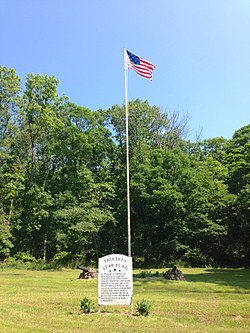Middlebrook encampment
"Middlebrook encampment" may refer to one of two different seasonal stays of the Continental Army in central New Jersey near the Middlebrook in Bridgewater Township in Somerset County. They are usually differentiated by either the date of the encampment or their chronological order (First vs Second).
Middlebrook Encampment Site | |
 A Thirteen Star Flag at the Middlebrook encampment is displayed continuously. | |
| Location | Middlebrook Road, Bridgewater Township, New Jersey |
|---|---|
| Coordinates | 40°34′45″N 74°32′16″W / 40.57917°N 74.53778°W |
| NRHP reference No. | 75001160[1] |
| NJRHP No. | 2485[2] |
| Significant dates | |
| Added to NRHP | July 3, 1975 |
| Designated NJRHP | May 8, 1975 |
The First Middlebrook encampment refers to the spring encampment of the
A portion of the first encampment site, known as the Washington Camp Ground, was added to the National Register of Historic Places on July 3, 1975. The Campground is located in Martinsville, a section of Bridgewater Township. The Middlebrook Encampment site includes part of the ridge of the First Watchung Mountain. Its position provided a natural fortress not only protecting the Continental Army but also overlooking the plains towards New Brunswick, where the British forces were stationed in 1777. A surviving earthen redoubt believed to date to the 1777 encampment is also located on the mountain within Washington Valley Park.[4] The strategic strength of the army's position on the Watchung or Blue Mountain ridge contributed ultimately to the success of the Continental Army by lengthening the war and wearying the British forces during both of the army's stays.[5][6][7][8]
First Middlebrook or the Spring Encampment (1777)

During the winter of 1776–1777, Washington initially encamped the Continental Army at
First flag: June 1777
It is largely conceded that it was at the Middlebrook encampment that the first official flag of the United States was unfurled, after a law to adopt a national flag had been passed by Congress on June 14, 1777. This event is commemorated annually since 1889 on July 4 with a changing of the flag, a reading of the Declaration of Independence, and the delivery of an historical address at the Washington Camp Ground. Also, by special order of Congress, a Thirteen Star Flag is flown 24 hours a day at the Washington Camp Ground.
Second Middlebrook or the Middlebrook Cantonment (1778–1779) [3]
Washington used the area around
Today

The Washington Camp Ground, on Middlebrook Road in Bridgewater Township, just north of Route 22, was deemed a historic site by local citizens in 1889, and entered the National Register of Historic Places July 3, 1975. The site is owned and preserved by the Camp Ground Association Washington Camp Ground Association, which also organizes the annual July 4 program at the site. The program includes a public reading of the complete Declaration of Independence, which has been read at the site each July 4 for more than 100 years.[12]
Various other sites related to the Middlebrook encampment are accessible to the public. These include Washington Rock State Park, an observation site on top of the Watchung mountain ridge, in Green Brook, Washington Valley Park in Bridgewater (nearby, but separate from, the Washington Camp Ground). A sign commemorating the encampment also stands in a now-developed area, at the corner of Chimney Rock and Gilbride Roads in Bridgewater. All five colonial homes that served as headquarters to the Generals during the cantonment were preserved at various times by local organizations beginning in 1898 with the Wallace House and all are now National Register Sites open to the public. See their respective websites for further information. A driving tour of the Middlebrook Cantonment area is available from the Heritage Trail Association and a "Five Generals Tour" is organized by Heritage Trail with the cooperating sites of the Middlebrook Cantonment.
See also
Nearby houses used as headquarters during the second Middlebrook encampment:
- Wallace House – General George Washington
- Van Veghten House – General Nathanael Greene
- Van Horne House – General William Alexander, Lord Stirling
- Staats House – General Friedrich Wilhelm von Steuben
- Jacobus Vanderveer House – General Henry Knox
References
- ^ "National Register Information System". National Register of Historic Places. National Park Service. July 9, 2010.
- ^ "New Jersey and National Registers of Historic Places - Somerset County" (PDF). New Jersey Department of Environmental Protection - Historic Preservation Office. August 22, 2016. p. 4. Archived from the original (PDF) on May 16, 2013.
- ^ ISBN 9798454162528.)
{{cite book}}: CS1 maint: multiple names: authors list (link - ISBN 9798454162528.)
{{cite book}}: CS1 maint: multiple names: authors list (link - ^ Lossing, Benson John (1921). The Pictorial Field Book of the Revolution, Vol. 1. New York: Harper and Brothers, Publishers. pp. 331.
- ISBN 9780813531137.
- ^ "Crossroads Feasibility Study". National Park Service. August 2002. p. 29. Retrieved 9 August 2014.
- ^ ISBN 9798454162528.
- ^ Elliot, Steven (2021). Surviving the Winters: Housing Washington's Army During the American Revolution, Vol 72 Campaigns and Commanders Series. University of Oklahoma Press.
- ISBN 9798454162528.)
{{cite book}}: CS1 maint: multiple names: authors list (link - ^ Washington, George (February 6, 1779). "General Orders, 6 February 1779". Founders Online, National Archives.
GW's principal subordinate generals occupied other private homes in the vicinity during the winter encampment.
- ^ "Middlebrook Encampment".
External links
- Description of second Middlebrook encampment
- Revolutionary War Sites in Bound Brook, New Jersey
- Wallace House, Somerville, NJ
- Staats House, South Bound Brook, NJ
- Washington Rock State Park
- Comstock, Sara (June 27, 1915). "To Washington's Old Camp Ground at Middlebrook". The New York Times.




